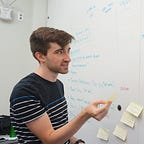Parallel Strategizing and Prototype Testing
This week we divided and conquered, but came together for a great testing session of last week’s prototype
Charging Ahead on Separate Design Fronts
With our new prototype in tow (and with two of our group members recovering from red-eyes from LA!), we set out on individual work this week. We needed to make progress on many fronts at once to move our initial design forwards: Visual design, product feasibility, technology plans, and further UX design.
Alexis moved closer to a unified design system. Using our Mood Board created on InVision, she put together five “looks and feels” of potential design styles including fonts, colors, and tone. We want to move forwards with a design that is somewhat mature/serious but with inviting colors and a light theme.
In our presentation last week, our clients challenged us to consider product feasibility. Jordan and Emily started to map out parts of the design feasibility and to start research on potential solutions. Things like how content is sourced, content scraping, machine learning abilities, and vetting content are being investigated.
We also tried to strategize what our final prototype should be at the end of the summer. We knew we wanted to code at some fidelity, but we especially want the algorithms and dynamic content to feel real for our final testing phase and demo. This leads us to more functional coding for a single-page web application. We continued to do research on the best tech to use for our build process.
Last but not least, we also worked towards fleshing out our first version of the app prototype, including an Explore feature, a Progression indicator, and Archive features.
Back to Summer Camp (for Prototype Testing?)
In the middle of the week, we interrupted our tasks to go back to summer camp! Well, we were able to go to a CMU summer camp for high schoolers and test designs with some students after their programming. All five of us went and conducted prototype testing in about 30 minutes! Not bad for a weeks’ worth of prototype research.
Working with the 9th and 10th graders was as always a nice break from heads-down design work. Although they were all in the same summer camp, they were from different parts of the country (and out of the country) with various career interests. Hearing different stories and feelings is always a create resurgence of “real life” in our design process.
Using mid-fidelity prototypes again (this time with more functions built out) we were looking for how students reacted and behaved in different parts of the app.
Synthesis and Future Research
After comparing notes, we put together a slide deck detailing the findings per screen. The slide deck deliverable was not only easier to organize than a Google doc, it was also easier to communicate back out to the team what the findings were.
The End of the Road for Mid-Fi Testing?
Although testing gave us some specific directions to iterate our main Question and Feed functionalities, it also opened up a lot more questions. We reassessed whether mid-fidelity testing an incomplete app was the best use of our design time. Things like leading questions and a lack of realistic user personalization held us back from deeply trusting all of our results. It felt like we were rushing UX design to get to the test, when testing should really be augmenting our design process. Users can’t suggest our design into existence.
We canceled our next round of user testing and hope to devote most of our time to UX design. This includes much deeper dives into algorithmic design. We hope to use less time-intensive gain creators like heuristic evaluation and internal critique to free up some time, before our later user tests in a few weeks. Stay tuned as always!
